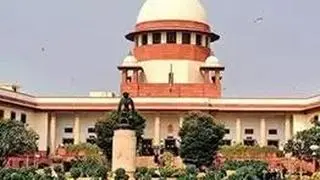In a stunning post-Covid second surge makeover, the ruling BJP sacked both Health Minister Harsh Vardhan and his deputy, Ashwini Choubey, along with ten other senior ministers and inducted into the Union Cabinet 43 youthful, professionally-qualified members largely with OBC/SC/ST backgrounds. The biggest reshuffle in Prime Minister Narendra Modi’s two terms inducted 15 new Cabinet rank Ministers and 28 Ministers of State (MoS).
Click here to read the full list of portfolio allocation
Women power

Finance Minister Nirmala Sitaraman (ce ntre) along with other Ministers who were inducted into the Modi Cabinet, in New Delhi, on Wednesday.

Finance Minister Nirmala Sitaraman (ce ntre) along with other Ministers who were inducted into the Modi Cabinet, in New Delhi, on Wednesday.
Seven women, including Meenakshi Lekhi, Pratima Bhowmik, Bharati Pravin Pawar, Anupriya Patel, Shobhaa Karandlaaje, Darshna Vikram Jardosh and Annapurna Devi, were sworn in. With Finance Minister Nirmala Sitharaman, Textiles Minister Smriti Irani, Ministers of State Niranjan Jyoti and Renuka Singh Sarota, the Union Cabinet now has 11 women.
In a tweet, Modi said: “I congratulate all the colleagues who have taken oath today and wish them the very best for their ministerial tenure. We will continue working to fulfil aspirations of the people and build a strong and prosperous India. #Govt4Growth.”
Resignations
In militaristic precision, the swearing-in of the new members followed the resignation earlier in the day of senior Ministers holding multiple portfolios — Harsh Vardhan, Ravi Shankar Prasad, and Prakash Javdekar — along with Education Minister Ramesh Pokhriyal Nishank, Social Justice Minister Thawarchand Gehlot, who was on Tuesday appointed Governor of Karnataka, Labour Minister Santosh Kumar Gangwar, Minister of Chemicals and Fertilizers D V Sadanand Gowda and Ministers of State Babul Supriyo, Dhotre Sanjay Shamrao, Rattan Lal Kataria, Pratap Chandra Sarangi, and Debashree Chaudhuri.
‘Educated’ Cabinet
The mammoth exercise combined professional and educational qualifications of the new inductees with their political and social efficacy of the BJP. With the new entrants, the Union Cabinet now has seven PhDs, three MBAs, 13 lawyers, six doctors, five engineers, seven former civil servants and 68 graduates. Jyotiraditya Scindia, for instance, is an MBA from Stanford. But he owes his induction as a Cabinet Minister to the switch he made to the BJP last year with his loyalists that toppled the Congress Government in Madhya Pradesh.
The “youthful” look of the Cabinet with the elevation of former MoS Anurag Thakur was complemented by the administrative experience and stature of former IFS officer Hardeep Singh Puri who, too, was elevated to the Cabinet rank.
The induction of Narayan Rane, former Chief Minister of Maharashtra, is entirely because of his insider knowledge of the Shiv Sena as he was a Sainik with Bal Thackeray before he quit the party to join the Congress then forming his own party and finally joining the BJP. Rane is the lone Maratha among the three Maharashtra inductees, who are from OBC and ST communities. Rane was effusive of another aspirant, Devendra Fadnavis. “I owe my appointment to Devendra Fadnavis,” he said after being sworn in.
The other entrants from Maharashtra include Bhagwat Kishanrao Karad from Aurangabad, a doctor with roots in the RSS, who belongs to an OBC community; Kapil Patil from the Bhiwandi-Thane region, yet another OBC representative in the Cabinet; and Bharati Pravin Pawar from Dhindori, Jalgaon, who is a doctor and belongs to an ST community.
Eye on Assembly polls
Preparations for Assembly polls next year, especially in the politically critical Uttar Pradesh, were visible in the induction of as many as seven ministers from the Hindi heartland State. Of the new-comers, three — Pankaj Chowdhary, Anupriya Patel and B L Verma — are OBCs; and three, including Bhanu Pratap Verma, S P S Bhagel and Kaushal Kishor, SCs. There is a lone Brahmin, Ajay Mishra, to placate the community, which accounts for an influential 13 per cent of UP’s population. The BJP combines its upper caste vote base with a strong outreach to OBCs, who used to traditionally vote for the Samajwadi Party, and Dalits, who had veered towards Mayawati’s Bahujan Samaj Party.
A similar focus was seen in West Bengal where the BJP continued its social engineering by inducting Shantanu Thakur, MP from Bangaon, who represents the powerful Matua community among the namashudras . Nisith Pramanik from the SC community was sworn in as an MoS for much the same reason.
New portfolios
Amit Shah will hold additional charge of the newly created Ministry of Cooperation. To avoid lack of coordination and overlap, several ministries to be merged.
Going forward, 53 such ministries are to be managed by 30 ministers.
Dharmendra Pradhan will be the new Education and Skill Development Minister; Aswini Vaishnav to be Railways Minister; Hardeep Puri will be Petroleum Minister and will continue to hold charge of Urban Development Ministry. Jyotiraditya Scindia gets Civil Aviation; Piyush Goyal to be Textiles and Consumer Affairs; Parshottam Rapala to get Dairy and Fisheries Ministry; and Anurag Thakur will be the new Information and Broadcasting and Youth & Sports Affairs Minister.










Comments
Comments have to be in English, and in full sentences. They cannot be abusive or personal. Please abide by our community guidelines for posting your comments.
We have migrated to a new commenting platform. If you are already a registered user of TheHindu Businessline and logged in, you may continue to engage with our articles. If you do not have an account please register and login to post comments. Users can access their older comments by logging into their accounts on Vuukle.